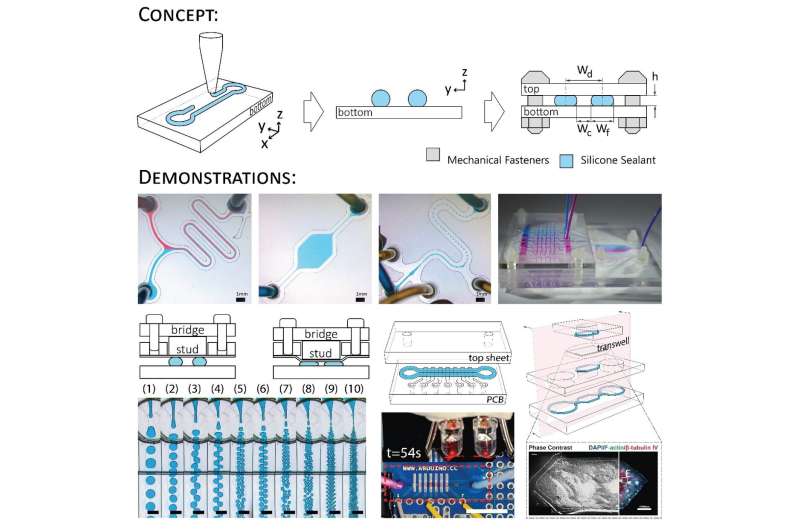Researchers develop a rapid, low-cost method to 3-D print microfluidic devices

Microfluidics is the manipulation and study of sub-microscopic liters of fluids. Technologies that utilise microfluidics are found in many multidisciplinary fields ranging from engineering to biology. Experiments can be performed on a device roughly of the size of a dollar coin, reducing the amount of reagents used, wastes produced, and the overall costs. Experiments can be conducted precisely at microscale levels, offering reduced reaction times and improved control over the reaction conditions.
Current gold standard for the fabrication of microfluidic devices is soft lithography, where elastomeric materials are casted on a mold fabricated in a cleanroom. Despite multiple desirable characteristics to fabricate microfluidic channels, however, soft lithography is a manual process that is difficult to automate. Typically, soft lithography has a design-to-prototype cycle of a few days.
3-D printing emerged as an attractive alternative to soft lithography. Not only can 3-D printers turn design into actual working prototypes in the order of hours, recent introduction of low-cost 3-D printers make 3-D printing more accessible in general to researchers. Current 3-D printing technologies for the fabrication of microfluidic devices have a few limitations, namely;
- available materials for 3-D printing (e.g. optical transparency, flexibility, biocompatibility),
- achievable dimensions of microchannels by commercial 3-D printers,
- integration of 3-D printed microfluidics with functional materials or substrates.
To overcome these challenges, researchers from the Singapore University of Technology and Design's (SUTD) Soft Fluidics Lab have developed an alternative method to apply 3-D printing for the fabrication of microchannels. The researchers applied direct ink writing (DIW) 3-D printing of fast-curing silicone sealant to fabricate microfluidic devices rapidly on various substrates (e.g. glass, plastic, and membranes). The design of fluidic channels is determined by the patterned silicone sealant, while the top and bottom transparent substrates serve to seal the channels. The use of transparent substrates allows the researchers to image the channel using a microscope. This method also permits the fabrication of microfluidic channels that are dynamically tunable in dimensions, which served as small channels as well as tunable flow resistors.
"By controlling the distance between the top and bottom substrates, we were able to precisely reduce the channel width up to around 30 microns. This lateral dimension of the channels would be difficult to obtain if commercially available 3-D printers were employed," said lead author Terry Ching, a graduate student from SUTD's Engineering Product Development pillar.
"Our approach to apply DIW 3-D printing allows direct patterning of microchannels essentially on any flat substrate" said Assistant Professor Michinao Hashimoto, the principal investigator of the project.
The team also demonstrated the ease of patterning of silicone barriers directly on an off-the-shelf printed circuit board (PCB), immediately integrating electrodes into the microchannels that would function as real-time flow sensors. Rapid integration of semi-permeable membranes to microchannels for culturing Keratinocyte cells was demonstrated.
More information: Terry Ching et al, Fabrication of integrated microfluidic devices by direct ink writing (DIW) 3D printing, Sensors and Actuators B: Chemical (2019). DOI: 10.1016/j.snb.2019.05.086




















